231/2
BIOLOGY
PAPER 2
TIME: 2HOURS
MARCH 2018
CATHOLIC DIOCESE OF KERICHO (CDK) EXAMS – 2018
PRE-MOCK
BIOLOGY PAPER 2
TIME: 2 HOURS
INSTRUCTIONS TO CANDIDATES
- Answer all questions in section A in the spaces provided. In Section B, answer question 6 (compulsory) and either 7 or 8 in the spaces provided after question 8.
-
- Eye colour in fruits flies is sex-linked. Red eye color R is dominant to white eye color r. A heterozygous red-eyed female fly was crossed with a white eye male
- Show the parental genotypes (1mk)
XRXr and XrY; - By means of a genetic cross, determine the genotypic ratio of the offspring (4mks)

- Explain why the actual phenotype ratio obtained from this cross could differ from the expected (1mk)
- Crossing over
- Mutations
- Show the parental genotypes (1mk)
- Name two disorders due to non-disjunction (2mks)
- Down's syndrome
- Klinefelters syndrome
- turners syndrome
- Eye colour in fruits flies is sex-linked. Red eye color R is dominant to white eye color r. A heterozygous red-eyed female fly was crossed with a white eye male
- The diagram below shows a section through the mammalian skin
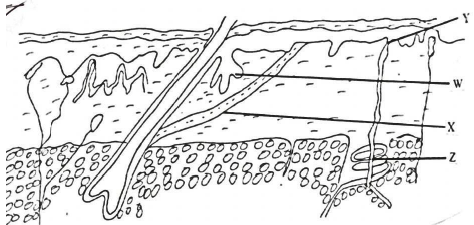
- Name the parts labeled W and X (2mks)
W - Sebaceous gland
X - Erector pili muscles - State the function of the parts labeled Y and Z (2mks)
Y - Produces melanin which protects the body against UV light/ determines the skin colour.
Z - Secrets sweat which evaporates to bring about cooling or sweat also removes excretory products/excess salts/ water. (2 mks) - Explain the changes that occur on the skin when it is cold (4mks)
Vasocontrition; hence less blood flows to the skin surface; reducing heat loss, no sweating; heat produced through metabolisms/shivering; is retained in the body.
- Name the parts labeled W and X (2mks)
- Examine the diagram below and answer the questions that follows
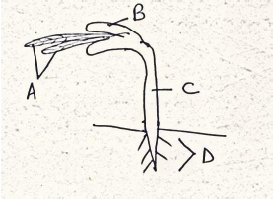
- Name the parts labeled A-D (4mks)
A- Foliage leaf
B- Cotyledon
C- Hypocotyl
D - Roots - State the type of germination exhibited by the seedling above (1mk)
Epigeal germination - State and explain three environment condition necessary for germination (3mks)
- Optimum temperature - For activating germination enzyme.
- Oxygen - For oxidising food materials to release energy necessary for germination
- Water - Solvent to dissolve substances, weaken testa to enable germination and hydrolyse enzyme.
- Enzymes - Dissolves the food materials and is also the medium of transport of dissolved food substances through the various cells to the growth region.
- Name the parts labeled A-D (4mks)
- The diagram below represents a food web in an ecosystem
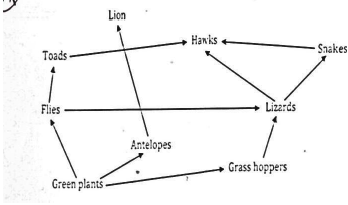
- From the food web above, construct a food chain ending with a quaternary consumer (1mk)
- Green plants —> Flies —> Toads —> Hawks
- Green plants —> Grasshoppers -> Lizards -> Hawks
- State the trophic levels occupied by;
- Lizard - Secondary consumer
- Green plants - Producers
- Antelopes - Primary consumers
- What would happen if leopards were introduced in the ecosystem (2mks)
- Population of antelopes would reduce
- Population of grass would increase
- Construct a pyramid having the following food chains: leaves of 10 large trees are fed on by millions of caterpillars which are in turn fed on by 50 kites (2mks)
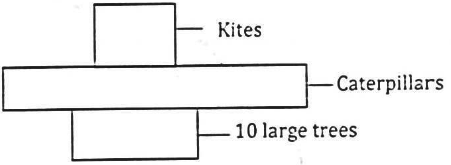
- From the food web above, construct a food chain ending with a quaternary consumer (1mk)
- Study the experimental set up below and use it to answer the questions that follow.
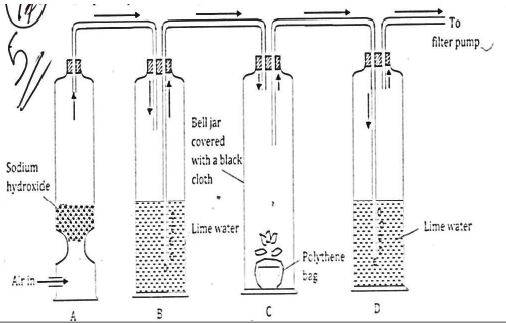
The filter pump is used to suck out air from the apparatus, reducing pressure in the apparatus causing the atmospheric pressure to force in air through jar A and moves through the apparatus as shown by means of arrows to the filter pump and observations are made on the appearance of lime water in Jar B and D
- What aspect of respiration is being demonstrated
Carbon IV oxide is produced during respiration. - State the roles of the following in the experiment
- Sodium hydroxide (1mk)
Absorbs the carbon IV oxide from the air entering the opparatus - Black clothing covering the bell jar (1mk)
To prevent photosynthesis from taking place as this would consume the carbon IV oxide produced - Polythene bag enclosing the plant (1mk)
- To prevent carbon IV oxide produced by micro-organisms in the soil from interfering with the result.
- Prevent soil water from condensing in the bell jar
- Sodium hydroxide (1mk)
- What observations would you expect to make in the lime water in B and D (2mks)
B - Lime water remains clear
D - Lime water turns white precipitate - Account for the results in (c)above (2mks)
B . Air entering into vessel B has no Carbon IV oxide as it has been absorbed by sodium hydroxide. D . The plant in the bell jar respired releasing carbon IV oxide which turn lime water in vessel D white - Suggest the changes one would make on the apparatus if a small mammal e.g. a mouse was used instead of a potted plant in the experiment (1mk)
The black cloth is not included because the animal does not use carbon IV oxide produced during respiration.
- What aspect of respiration is being demonstrated
SECTION B (40MKS)
Answer question 6 and either number 7 or in the spaces provided after questions 8
- A person had stayed for 24hrs without food. Then he was served with a well-balanced meal after which the concentration of glucose and amino acids in the blood were determined every one hour for the next 8 hours after the meal, the concentration were measured as blood passed through the hepatic portal vein and hepatic vein. The results were as shown in the data below.
-
Time in hours
Concentration of glucose and amino acids in blood (mg/100cm3 of blood)
Hepatic Portal vein
Hepatic Vein
glucose
Amino acids
glucose
Amino acids
0
79
1.0
85
1.0
1
79
1.0
85
1.0
2
160
1.0
110
1.0
3
140
4.0
100
3.0
4
120
6.0
90
3.0
5
100
5.0
90
2.0
6
90
2.0
90
1.0
7
90
1.0
90
1.0
8
90
1.0
90
1.0
- On the same axis plot graphs of glucose concentration in hepatic portal vein and hepatic vein against time (7mks)
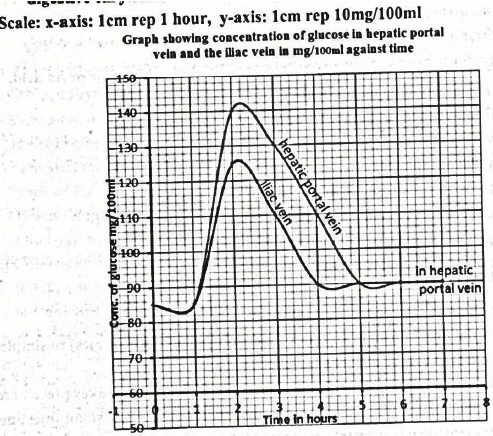
- Account for the difference in blood sugar level in hepatic portal vein and hepatic vein
- 0-1 hour: Concentration is constant or low or below normal levels in blood. No digested foods/glucose from the intestines hence no absorption of digested material.
- 1 - 2 hours: Sharp increase in concentration of glucose in blood; more absorption of glucose after digestion of the food.
- 2 - 4 hours: Glucose concentration declining/decreasing; less glucose being absorbed; (more glucose being converted to glycogen in the liver cells. Some used for tissue respiration), because all the food has been digested.
- 5-7 hours: Concentration of glucose stabilizes or is constant/ digestion has been completed therefore no more absorption and excess has been converted to glycogen or respired.
- Give one reason that delayed increase in amino acids concentration in hepatic portal vein (1mk)
- The concentration of glucose in the iliac vein is lower than in the hepatic portal vein;
- Glucose in hepatic portal vein is not regulated by the liver. Glucose that leaves the liver to iliac vein is regulated.
- Account for the difference in concentrations of amino acids in hepatic portal vein and hepatic vein 3rd -6th hrs (2mks)
Protein takes longer to digest - Name the enzyme that completes fat digestion in man (1mk)
lipase enzymes
-
-
- Describe how gaseous exchange takes place in terrestrial plants (12mks)
Gaseous exchange takes place in spongy mesophyll and involves carbon IV oxide and oxygen gases.
During the day carbon IV oxide diffuses into air spaces of the spongy mesophyll due to concentration gradient; from the air spaces then the carbon IV oxide diffuses into photosynthetic cells in solution form;
In photosynthesis carbon IV oxide is used while oxygen is produced; Some of the oxygen is used in respiration while the rest of the oxygen diffuses out through the stomata due to a concentration gradient: At night oxygen diffuses into air spaces of the spongy mesophyll; Due to concentration gradient: The oxygen dissolves into a thin film of moisture and then diffuses into the cells in solution form and is used in respiration during which carbon IV oxide is produced;
It then diffuses out of the leaf through the stomata due to a concentration gradient: At night carbon IV exide accumulates in the leaf since photosynthesis does not take place; Some gaseous exchange also takes place through the cuticle and epidermis of young leaves and stems: Also epidermis of roots carries out gaseous exchange with the air in the soil; Some plants have breathing roots called pneumatophoes through which gaseous exchange occurs; in aquatic woody plants these roots provide a wide surface area for gaseous exchange due to many lenticels; Gaseous exchange also occurs through lenticels found in older stems. The cork cells at the lenticels are loosely packed to enable gaseous exchange between the atmosphere and cork cells: - Explain how blood clotting occurs (8mks)
When blood vessels are injured, platelets exposed to air rapture; (on damaged tissue) to release thromboplastin (Enzyms thrombokinase); which initiates the clotting process; Thromboplastin neutralises heparius; (an anti-clotting factor) and activates prothrombin to thrombin; in presence of calcium ions; thrombin ... fibrin. which forms a meshwork of fibres on
- Describe how gaseous exchange takes place in terrestrial plants (12mks)
-
- Describe the structural adaptations of mammalian heart to its functions (10mks)
The heart has atrioventricular/tricuspid and bicuspid valves and semi-lunar valves which allow blood to flow in one direction/prevent backflow of blood; valves have nonelastic chordae tendonea/ tendons which prevent atrioventricular valves from turning inside out into auricles during ventricular systole;
The heart has thick muscular walls which contract to pump and push blood; The heart is made of cardiac muscles which are myogenic/contract and relax without fatigue; the heart has sino-atrio node and atrio-ventricular node which initiate the cardiac muscles impulses; hence stimulate the contraction of the atria and ventricles respectively;
The heart is served with vagus and sympathetic nerves which regulate the rate of heart beat; (depending on the body's physiological requirements) The cardiac muscles are served by coronary artery and coronary vein, coronary artery supplies oxygen/nutrients; to heart muscles whereas coronary vein remove metabolic wastes/carbon (iv) oxide:
The heart has specialized interconnected cardiac purkinje fibres which spread the wave of excitation throughout the heart muscles; the heart has four chambers which hold blood briefly before it is pumped to the lungs and the rest of the body.
The heart has a septum wall that prevents mixing of oxygenated blood on the left of the heart) from mixing with deoxygenated blood on the right side of the heart). The heart has venacava and pulmonary vein that transport blood to the auricles (from the rest of the body) and lungs respectively, The pulmonary artery and aorta transport blood to the lungs, and the rest of the body (respectively)
The heart is enclosed by pericardium memberane which prevents it from overstretching, the pericardium secretes the pericasdial fluid which lubricates the heart and reduce friction as the heart moves with the inner membrane; the pericardium is covered with a layer of fat that acts as shock absorber. - Explain how the herbivores (organism) are adapted to their mode of feeding (10mks)
- Have horny pad on the upper jaw): against which grass is cut by lower incisors
- Have long tongue; that turn food/move it for grinding:
- Have diastema; (a gap between front and back teeth) to allow food to be turned in the mouth;
- Jaws can move side by side; to enable grinding of food;
- Teeth (Molars and premolars) have large cusps; for crushing/grinding vegetation;
- Describe the structural adaptations of mammalian heart to its functions (10mks)
Download Biology Paper 2 Marking Scheme - CATHOLIC DIOCESE OF KERICHO (CDK) EXAMS – 2018 PRE-MOCK WITH MARKING SCHEME.
Tap Here to Download for 50/-
Get on WhatsApp for 50/-
Why download?
- ✔ To read offline at any time.
- ✔ To Print at your convenience
- ✔ Share Easily with Friends / Students

